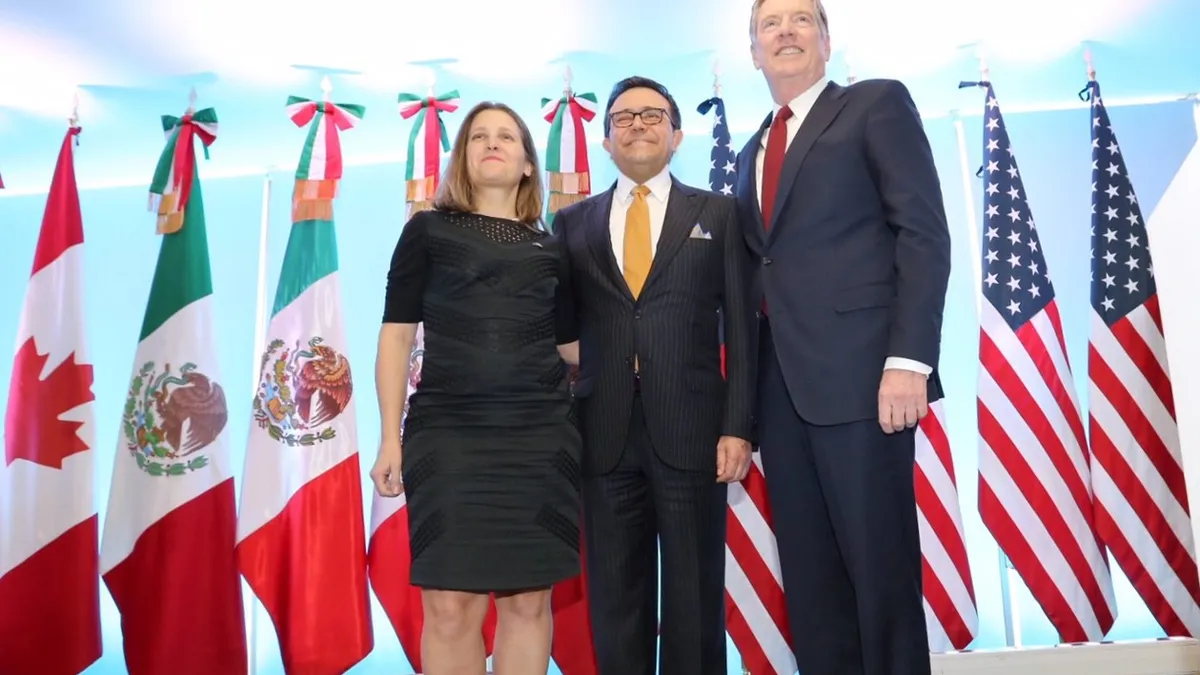Dive Brief:
- The U.S., Canada and Mexico officially have a new trade deal binding their economies: On Sunday, the United States-Mexico-Canada Agreement (USMCA) was reached.
- The three countries are expected to sign the deal by the end of November. Congress, however, must ratify the deal — such a vote is not expected (or possible) until 2019.
- If approved, the USMCA would replace the North American Free Trade Agreement as the region's economic standard. The deal comes after 16 and a half months of negotiations among the parties.
My most sincere and heartfelt congratulations to my colleagues Minister @cafreeland and Ambassador Lighthizer on the conclusion of the Trilateral Agreement between Mexico, Canada, and the US.
— Ildefonso Guajardo (@ildefonsogv) October 1, 2018
Dive Insight:
The full text of the deal reveals new rules designed to bolster labor protections, increase certain industries' market access, remove technical barriers to trade and incentivize regional manufacturing.
In a nutshell, negotiators drafted a deal designed to "do no harm," as the business community demanded for over a year. Despite a few give-and-takes, and heated rhetoric over the past year, the original trade foundations of the North American Free Trade Agreement (NAFTA) remain largely intact.
The things that did change, however, promise to drastically alter business in a few industries. A few examples:
- Automotive supply chains face stricter tariff conditions — Vans, light and heavy vehicles are now subject to more strict rules of origin, requiring at least 70% of a product's value to originate in the U.S., Canada or Mexico if it is to benefit from USMCA rules. In addition, 40% of labor used in the region must meet high salary standards.
- Labor standards will be more strictly enforced — The three countries agreed to International Labour Organization standards and to prohibit any imports derived from forced or obligated labor. Enforcement mechanisms were added to address labor issues.
- Canada's dairy, egg and poultry markets are now more open — Canada's method of regulating agriculture supply in its markets (CBC explains it best) almost derailed a new deal, as the U.S. argued this priced out its producers. Under the new deal, dairy farmers receive increased market access.
It's also important to note a few things that did not change, but will prove equally significant:
- The textile supply chain remains intact — This is a win for Mexico's garment industry, as the government made clear in a summary of the deal. The deal "eliminates the possibility of imposing restrictions (upon the garment-textile chain) that create obstacles for regional value chains to function," the summary reads.
- Dispute settlement mechanisms remain (largely) intact — The investor-state dispute settlement clauses (ch. 11), the anti-dumping arbitration request rules (ch. 19) and the intellectual property rules (ch. 20) remain in the deal.
- Mexico's state-owned enterprises remain protected — The president-elect of Mexico favors the state's control of the country's oil industry and fought to keep protections under the new deal. In its summaries, Mexico also claims a victory in the deal's provisions to boost investment in telecommunications.
All in all, many of the "poison pills" which threatened to derail any deal a year ago were either averted or negotiated. The USMCA will be revised every six years, allowing the countries to consistently renegotiate the trade deal and avoid a NAFTA-like scenario wherein a country's withdrawal is either likely or necessary.
The new trilateral trade agreement in North America is a state-of-the-art instrument that will bring great economic benefits to Mexico, Canada and the US. #USMCA
— Ildefonso Guajardo (@ildefonsogv) October 1, 2018
"USMCA will give our workers, farmers, ranchers and businesses a high-standard trade agreement that will result in freer markets, fairer trade and robust economic growth in our region," United States Trade Representative Robert Lighthizer and Canadian Foreign Affairs Minister Chrystia Freeland said in a joint statement. "It will strengthen the middle class, and create good, well-paying jobs and new opportunities for the nearly half billion people who call North America home."














